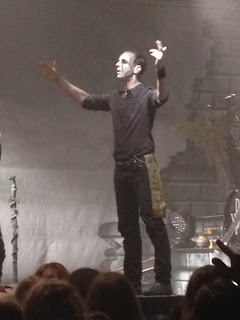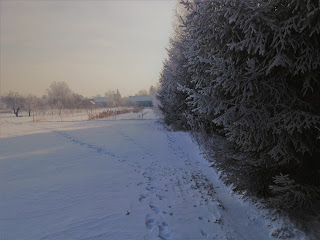Sunday 29 January 2017
Thursday 26 January 2017
Epica Live at Warsaw Progresja 24th January 2017
A few shots from Epica live at Warsaw Progresja from Tuesday evening:
From the recent album, 'The Holograph Principle', 'Beyond the Matrix' and 'Divide and Conquer' were always going to be my favourite tunes, and so it proved.
Then, from the older stuff, it was one great tune after another ('Essence of Silence'; 'Sancta Terra'; 'Cry for the Moon'; 'The Obsessive Devotion' etc.)
Had a great night watching Epica at a students' festival in Warsaw a couple of years ago, and thoroughly enjoyed them again on Tuesday night at the Progresja.
Hope to catch this great band again, of course.
Wednesday 25 January 2017
Powerwolf Live at Warsaw Progresja
Tucked in between Epica and Beyond the Black, I got to see Powerwolf last night.
Didn't really know what to expect, but enjoyed Powerwolf much more than I'd imagined.
Some really good tunes and melodies mixed in with Catholic Church and werewolf imagery.
My two favourite songs of the set were 'Coleus Sanctus' and 'We Drink Your Blood'.
Yeah, I'm really glad I caught Powerwolf, they were much better than I'd expected.
Monday 23 January 2017
Warsaw: Workmen on a Church Roof
From these two pictures, you can just about make out a couple of men working in freezing conditions on the Lutheran church roof in Warsaw city centre. Just wish I'd had my camera to capture this better.
Sunday 22 January 2017
Warsaw: Wooden Crosses outside the Presidential Palace
Was walking past the Presidential Palace the other day, and couldn't help but notice the beautiful, handmade, small wooden crosses in front of the Smolensk Air Disaster memorial:
Thursday 19 January 2017
Thomas Hardy's 'The Hand of Ethelberta'
Started reading Thomas Hardy's 'The Hand of Ethelberta in mid-December and finished it a couple of weeks ago, so I read it in roughly a month. Read most of it while regulary travelling on a tram to and from work in Warsaw, and during a couple of return Warsaw-Zamosc (in Eastern Poland) mini-bus journeys.
In August last year, I read 'Desperate Remedies', Hardy's first published novel, and, for me, there was just too much intrigue in it, although it was quite exciting to see it all unfold towards the end of the novel. In contrast, 'The Hand of Ethelberta' seemed to be developing into a similar intrigue, but unravelled itself of most of the major intrigue early on after about 100 pages or so (with Christopher Julian's discovery of Ethelberta's lower-class parents and many siblings). After this, the novel turns into an enjoyable farce/comedy of manners.
In the Penguin edition I have, I also clearly benefitted from reading Professor Tim Dolin's Introduction to the novel. This immediately placed 'The Hand of Ethelberta' alongside 'Desperate Remedies' and 'A Laodicean' (which I've just started reading) as one of Hardy's "honourable failures" or "wooden spooners". Having now read 'The Hand of Ethelberta', I find myself returning to Professor Dolin's Introduction to further reflect on the novel.
In conjunction with Dolin's Introduction, I can see that 'The Hand of Ethelberta':
* pokes mickey-taking type fun at upper-class, London dinner parties and other gatherings as a "satire of life in high society" with its "inflexible social codes . . . ritual gatherings, society gossip . . . pattern opinions
. . . mechanical social world . . . empty imitation and repetition . . . inherited rules of conduct to individuals" which is incompatible with genuine human authenticity/individuality
* does not contain any of the fully "doomed heroes and heroines fatally alienated from their (mostly rural) environments" that appear in Hardy's great tragedies ('Tess'; 'Jude'; 'The Mayor of Casterbridge'; 'The Woodlanders'; 'The Return of the Native' etc.)
* does not really allow the reader to see who Ethelberta Petherwin (Berta Chickerel) really is, as she is constantly hidden behind "her own multiple identities"
* unusually shows a young woman, (Ethel)Berta bearing the responsibility for (and sacrificing her own happiness) for fulfilling the role of being "the patriarch of her family"
* is essentially "a story of forsaken identity and compromise", as, through her marriage to the old rascal, Lord Mountclare', Ethelberta must more fully forsake her lower-class family identity, for them to thrive better socially, with her own life amounting to no more than an artificial lie (with the real Ethelberta never revealing herself)
* may be viewed as being somewhat autobiographical, as like Hardy himself, Ethelberta makes her way in higher-class society through writing and disguising her lower class background
* may be viewed thematically as containing a central tension or contrast between "artificial" and "authentic" existence e.g. between Ethelberta and her lower-class family members, especially her sister Picotee
* may be viewed as an accumulative critique of a "woman who will not drop her public facade", remaining a "stubbornly superficial creation" throughout the novel
* may be viewed as a satire of "slavish social convention" being used to cover up "the emptiness of existence" and to negate freely created (authentic) individual experience that can give meaning to life (in this sense, the novel reads something like existenstialist philosophy).
* is a warning against filling one's self with "conventionality" as it essentially amounts to becoming what wider society prescribes one should be
Besides the above, I have a few thoughts of my own that are kind of independent of Professor Dolin's inspirational Introduction. The first is that for me, Lord Mountclere is more than just a mere old rascal, as, near the end of the novel, his servants seem to genuinely lament the loss of his party-like/drunken benevolence/vitalism which is stripped from him by Ethelberta's regimental regime of orderliness. In other words, I felt forced to sympathise with Mountclere and his servants having their sense of drunken fun ripped away from them by Ethelberta.
I also felt some sympathy towards Christopher Julian and his sister Faith. In a world where human fate is fair-minded, Christopher would've surely married Ethelberta, but life is often sadly not like that. Still, there seems to be some kind of resolution for the earnest-minded Christopher as he looks to be in the process of winning (Ethelberta's sister) Picotee's hand at the conclusion of the novel. For me, Picotee may be viewed as a kind of 'Ethelberta in embryonic form', thankfully, without the crippling social pretensions. As for Faith, yes, she's a background character, but, still, I get the sad sense that this is a young woman who allows life to simply fly by without doing anything adventurous or substantial to build up an authentic life-story (she seems to just want to be with others without seriously developing herself).
Finally, I've got to say that I enjoyed some of the colloquial language in the novel, especially that used in Hardy's 3rd person narrative form. For example, I would never have dreamt that the word "toss-pots" would turn up in a Hardy narrative, but it did.
Thus, all in all, 'The Hand of Ethelberta' was a surprisingly good read, nothing like anything I've encountered in Hardy before, being unusually sandwiched chronologically between 'Far from the Madding Crowd' and 'The Return of the Native' in the Hardy canon.
Wednesday 18 January 2017
Warsaw: Small Nativity Scene on Krakowskie
Also passed this small Nativity Scene on Krakowskie:
Looks as if people may've been adding small flags to the Nativity Scene or maybe it was just set up this way. In particular, I like the way the Cross has been positioned directly behind the Nativity Scene, it adds to the significance.
Tuesday 17 January 2017
Warsaw: New Year's Eve Decorations by Daylight
Enjoyed the New Year's Eve/Christmas decorations in and around Krakowskie and the Old Town so much that I had to go and see what they looked like in the daylight:
And I wasn't disappointed, it was just interesting to see what they were like without being lit-up:
Of course, I wasn't surprised to see that quite a lot of thought and planning had gone into the Krakowskie/Old Town Christmas/New Year's Eve decorations:
Like all the decorations above, the Christmas bulb decoration below, outside the Arkadia shopping centre, was still proudly standing in mid-January:
Good to see that Poles are never quick to get rid of their Christmas/New Year's Eve enchantment.
Sunday 15 January 2017
Warsaw: Lit-Up Palace of Culture Entrance
Had just got out of a small mini-bus from Zamosc when I noticed that one of the main entrances to the Palace of Culture was nicely lit-up.
Friday 13 January 2017
Zamosc: Incredible Wooden Building
Passed this incredible, wooden, tower-type building during a stroll near Zamosc coach station:
From the things around it, this building stood out as being absolutely stunning.
Thursday 12 January 2017
Eastern Poland: Snowy Fir Trees
Found it relaxing walking alongside this plantation of fir trees in Eastern Poland:
Was just following the footsteps of the dog I was out walking with:
Of course, both fir trees and snow are magically associated with Christmas in European Christian culture.
Was really a pity to have to turn round and start walking back:
Monday 9 January 2017
Warsaw: New Year's Eve Mobile Shots
A few mobile shots from New Year's Eve in Warsaw.
You could do a lot worse than walking down Krakowskie and then through the Old Town on New Year's Eve.
Friday 6 January 2017
Bury (Lancashire): St. Joseph's Early 1970s Class Picture
One of my old classmates sent this picture (from St. Joseph's Catholic junior school in Bury) round Facebook recently, taking me back over 40 years.
Tuesday 3 January 2017
Monday 2 January 2017
Zamosc: Eastern Orthodox Cemetery
During my hour to spare at the Zamosc bus/coach station, I was able to have a look inside the Eastern Orthodox cemetery nearby.
The small chapel-type building below particularly caught my eye:
Read quite a lot about Eastern Orthodoxy during early adulthood, and deeply respect this ancient branch of Christianity.
Subscribe to:
Posts (Atom)




















































